They say the inimitable heart and soul of Italy lies here in Borghi, the small villages that dot the country, preserving a timeless lifestyle. In their churches and fortresses, the DNA of European history is distilled as ponds from the raging river of time. These towns, once at war with each other, grew up around the castles and palaces of the noble families who ruled and protected.
 |
|
Rosa Maria Musco, founder of the Borghi Italia Tour Network. (Photo: Lee Fryd) |
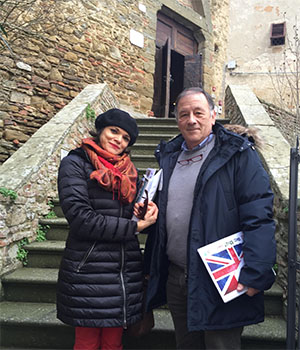 |
|
Fiorello Primi, President of The Most Beautiful Villages of Italy, and Panicale Culture Assistant Sabrina Caciotto, outside a Panicale town gate. (Photo: Lee Fryd) |
Many of these noble descendants still reside in family castles, becoming mayors and councilmen. Now, they protect their villages through the non-profit association, Fiorello Primi, co-founded in 2001: I Borghi più Belli d’Italia (The Most Beautiful Villages of Italy). The Mayor of the Castiglione del Lago Borgho for ten years, Primi turned a dream — modeled after Les Plus Beaux Villages de France — into an internationally renown association comprised of 250 Borghi, which he still spearheads as President. Their battle: to negotiate the line between the kind of tourism which would support their lifestyle and that which would homogenize and destroy it.
A general in this holy war is Rosa Maria Musco, who garners converts as the exclusive marketing arm of the association. The former Art Director of The Italian Opera in the world by the Italian Institute for Opera and Poetry by UNESCO, she received certification to become the official Tour Operator of I Borghi Più Belli d’Italia in 2014. And whether her new life is one long holiday or all work, depends on your vantage. Musco hasn’t taken a day off from sourcing sites and presenting them to the world in the past two years.
 |
|
Trasimeno Lake in Umbria. (Photo: Lee Fryd) |
Luxury without crass commercialism is her cri de coeur. Her tours bring small groups to renovated villas, castles, B&B’s and indigenous fare. “Time slows down here,” she says. “Each Borgo is unique. But, they all have quality of life, clean air, pure food and warm people.”
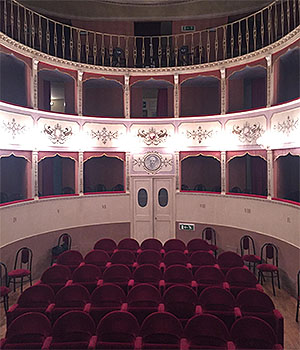 |
|
Caporali Theatre in Panicale. (Photo: Lee Fryd) |
To give us a taste of the treasures on her tours, she drove us to the Trasimeno Lake in Umbria. “With its mountains, low light, dark atmosphere, and narrow winding streets, Umbria is a mystical region of wizards and saints,” she whispered, as we drove past olive and cyprus trees punctuating the horizon, and sheep grazing in fields. First stop was Panicale, a town of roughly 6,000, founded by herdsmen in 2,000 BC. The castle and constitution was created in the 9th Century. Its churches and frescoes, built in the Renaissance. Mayor Giulio Cherubini’s Culture Assistant Sabrina Caciotto pointed out the 17th Century portrait of his Cherubini ancestor, who once ruled the town. There was an uncanny resemblance.
The old walled city — its gates, museums and small, cobbled roads — tell the story of a great defeat against Hannibal’s army and a flourishing Renaissance period. A recently restored masterpiece by Raphael’s teacher, Pietro Perugino (born Pietro Vannucci), the “Martyrrdom of San Sebastiao,” is located in the Church of San Sebastiano. The church of San Michele houses a fresco by the famous Renaissance painter Tommaso Fini (later called Masolino da Panicale). A late 17th Century theater — with 180 seats total — remains the stage for the local theater company. Their Lace Museum houses veils of Queens.
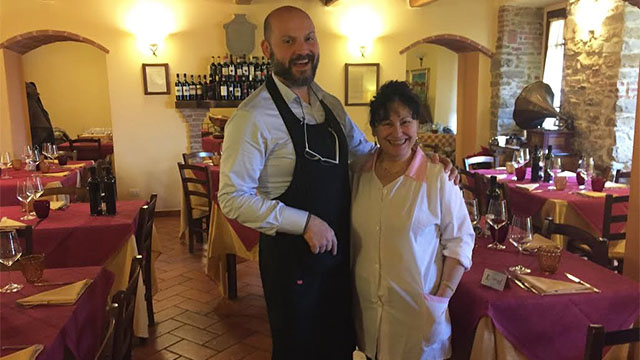 |
|
Welcome to Da Masolino inside Panicle’s old city walls. (Photo: Lee Fryd) |
In the heart of the old city, we had lunch at Da Masolino, where the vintage of the famous Umbrian olive oil served was examined as carefully as the Orvieto wine. Later, Mama Bruna, her broad smile, unadorned face and short stocky frame straight out of central casting, came out of the kitchen, accustomed to daily accolades for her homemade pasta.
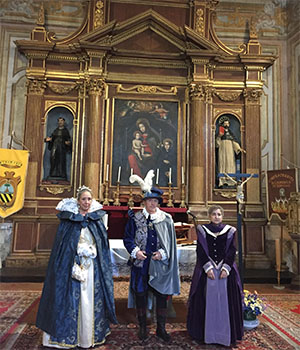 |
|
Transported back to Renaissance times in the Palazzo della Cogna in Castiglione del Lago. (Photo: Lee Fryd) |
Then it was off to Castiglione del Lago, on another side of Lake Trasimeno, bordering Umbria and Tuscany. Its population — a whopping 15,000 — swells in the summer when the lake beckons international travelers to its shores.
Inside the old city walls, we settled into a 13th Century two story palazzo renovated as the Antica Gabella Bed & Breakfast. The charming owners make coffee and breakfast for guests in apartment-sized suites, complete with living rooms, kitchens and antique marble sinks.
There was one more short foray. The 16th Century Palazzo Ducale and its walled fortress overlooking the lake. Once it protected the village. Today, its courtyard hosts summer concerts. In the museum, locals, dressed in period costume, recreated a Renaissance dance, then served indigenous liquors and sweets. Its Hall of Annibale and the Hall of Cesare are still being used for town hall functions. “There is where I sat,” former Mayor Primi pointed out. Standing amongst the Late Renaissance frescoes, then walking the high fortress overlooking the lake, we understood viscerally why Primi was inspired to create the Borghi Più Belli d’Italia brand.
 |
|
Fortress of the Lion in Castiglione del Lago. (Photo: Lee Fryd) |
That night, we chatted with Gloria Tommasini at the Cafè Noir, on the lake. A school teacher as well as a part time guide, Gloria grew up in Castiglione del Lago. She spent ten years working in Germany, only to return, and within a week, meet the man she would marry. “I wanted to raise my children here,” she told us. “It was beautiful growing up in this community and I wanted them to have the same sense of place and roots.”
 |
|
Mama Bruno comes out of her kitchen in Da Masolino. (Photo: Lee Fryd) |
She, as so many before, answered Umbria’s siren call to Saints and Sinners — to sip its wine, enjoy its beauty and find one’s inner soul.
For more information about Borghi Italia Tour Network, visit www.bitn.it.
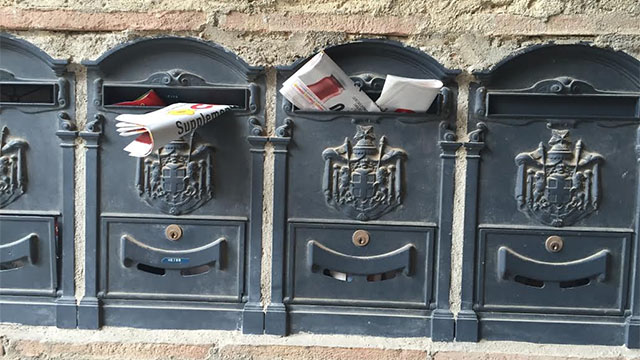 |
|
The timeless Italian Borghi. (Photo: Lee Fryd) |












